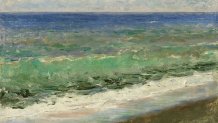When American painter William Merritt Chase wrote, "Everything he did was interesting," he was referencing his affinity for Spanish painter Mariano Fortuny y Marshal.
Now the two painters' beach-inspired works are displayed together for the first time in At the Beach: Mariano Fortuny y Marshal and William Merritt Chase, a summer-themed exhibition at the Meadows Museum, SMU in Dallas through Sept. 23.
"We love to do this kind of exhibitions that are kind of a revision of this great artist of the past that also some other major artist looked at and were influenced by them," Mark A. Roglán, The Linda P. and William A. Custard Director of the Meadows Museum and co-curator of this exhibition, said.
Fortuny's final masterpiece, Beach at Portici, is the Meadows Museum's recent acquisition. The painting was notably featured at Chicago's 1893 World's Columbian Exposition and Fortuny was admired in America during his lifetime and for several years after his death at age 36.
"He was like a rock star," Amanda W. Dotseth, Meadows/Mellon/Prado Fellow and co-curator of the exhibition said. "Fortuny was also a great commercial success. He would have been on the radar of Chase and American artists who made the effort to go to Europe to learn to paint."

Beach at Portici is paired with Chase's Idle Hours, another beach scene depicting the serenity of family members doing nothing on loan from the Amon Carter Museum of American Art in Fort Worth.
Local
The latest news from around North Texas.
Because Chase served in an advisory role for the 1893 World's Columbian Exposition and had a relationship with New York collectors, he was most likely familiar with Beach at Portici.
"I think he knew it and perhaps internalized it in terms of technique and subject matter," Dotseth said. "From the formal qualities to the subject matter to the method of painting outside on a beach, the amount of the composition that is given up to the plants, grass moving in the breeze or clouds in the sky and that shifting color that you get from the sun off the clouds, there's all of these formal elements that overlap."
In Fortuny, Chase found an artistic kindred spirit. "I think they were both academy-trained and they were both very good draftsmen, they were very good painters. They understood technique, they understood the importance of the craftsmanship of being a good painter," Roglán said.
Fortuny epitomized the taste of the moment, focusing on the exotic, capturing life in Spain and appealing to American ex-patriates living in Paris and wealthy collectors like the Vanderbilts and Morgans.
"Not only is he a good painter, but he hit the nail on the head when it came to subject matter," Dotseth said. "There's been a lot of interesting research on this late 19th century/early 20th century kind of 'Spanish craze' as it is called. Americans are also interested in Spain and its artists so I'm sure it helped that Fortuny was Spanish and a lot of his work depicted Spain too."
Both paintings were painted outside, or en plein air, with bits of sand and grass still embedded in the oil paint. French Impressionists made technique made popular when Fortuny painted Beach at Portici. "He was also interested in something modern artists, shall we say, were interested in making theirs, which is 'Let's paint directly outside, let's try to capture all the light, let's try to make movement, the air, the atmosphere and the scene become real,'" Roglán said.
The subject matter was also something revolutionary.
"I think the subject matter is really important, this idea that he is painting his family and scenes of modern life. That's something we associate with French Impressionists, that you don't have to paint a history painting or genre scene. You can paint your contemporaries," Dotseth said. "This is leisure time as the subject of grand art, so what does this say about society at the time?"

The paintings do not focus on a specific landscape. Fortuny's painting is set in southern Italy and Chase paints a scene in Long Island, New York, but both settings could be any beach in any country. Fortuny's painting depicts a slice of life, including fishermen, society ladies and children playing.
"This is a kind of setting where all classes are coming together and they are all just spending a wonderful day on the beach," Roglán said. "There's something magical about that painting, about the light and how it bounces back from the painting and comes out. It's so vivid and alive. It's quite extraordinary."
When coupled, the paintings share a conversation about artistic inspiration and reminiscences of lazy summer days.
"Some people that know of Fortuny will learn how he influenced other great artists. People that know about William Merritt Chase will suddenly discover an artist who may have influenced him. People who do not know Fortuny and Chase will be able to see how all these great artists and art are interconnected," Roglán said. "And maybe they bring back good memories of you, yourself, having spent time on the beach with your family."



